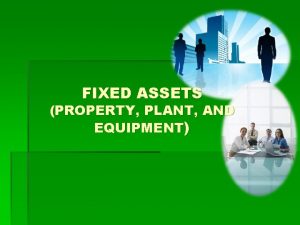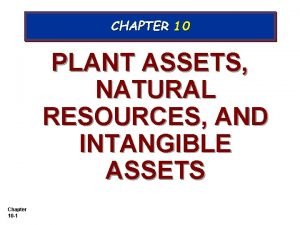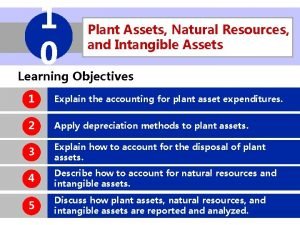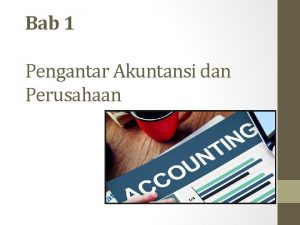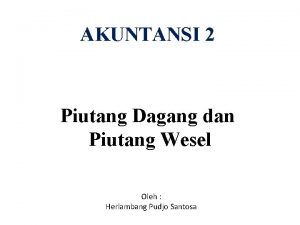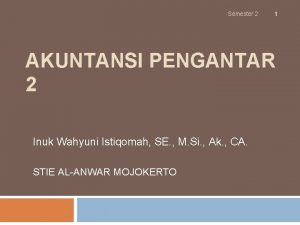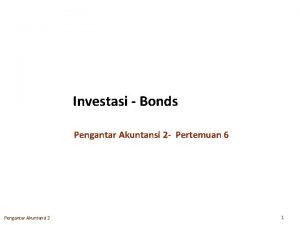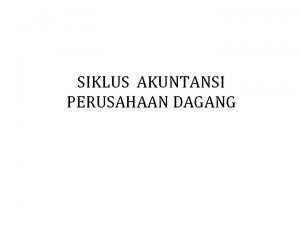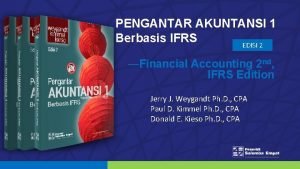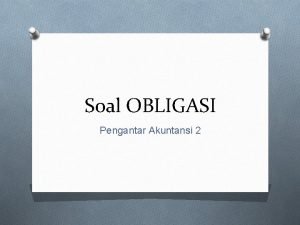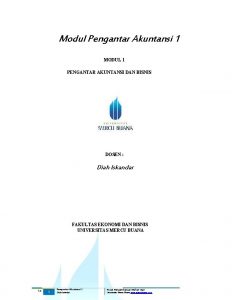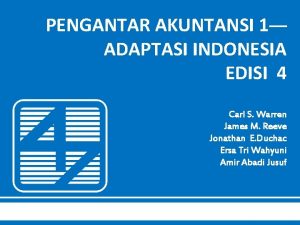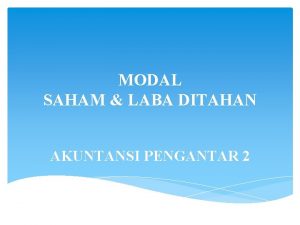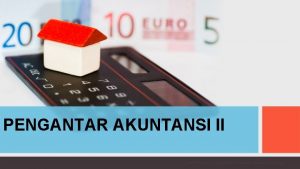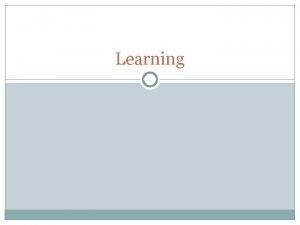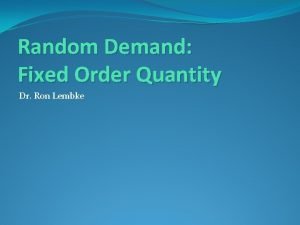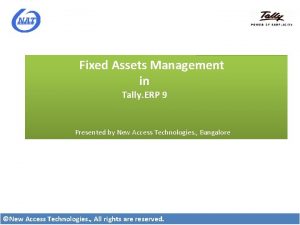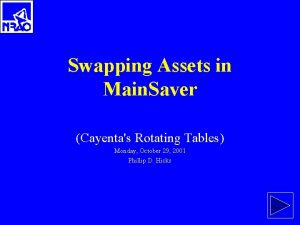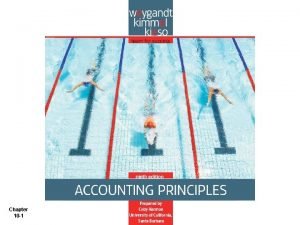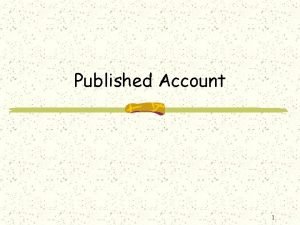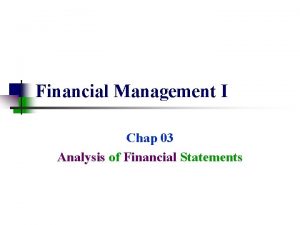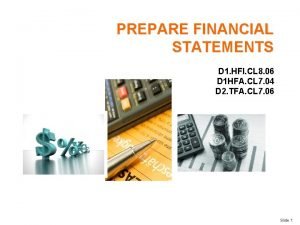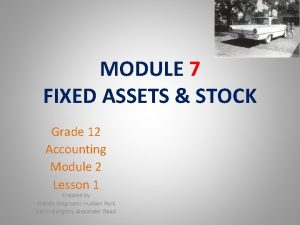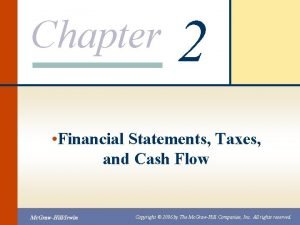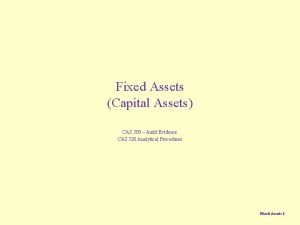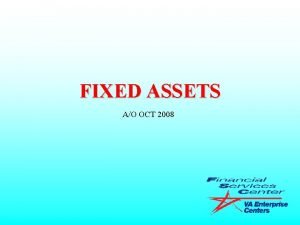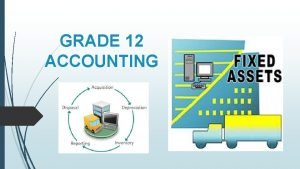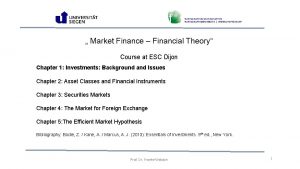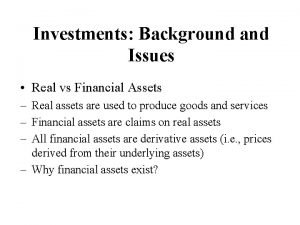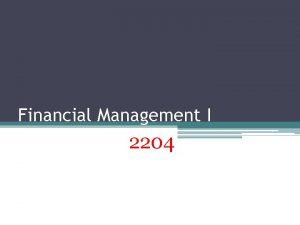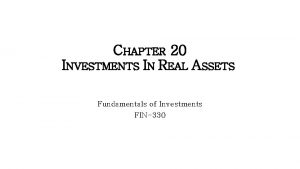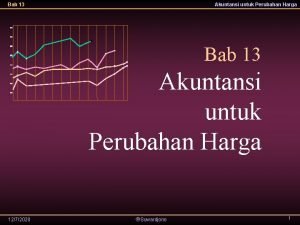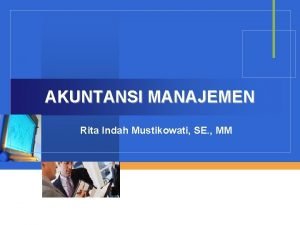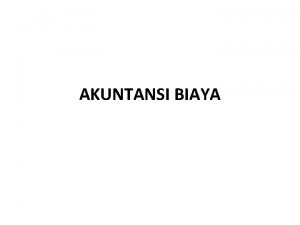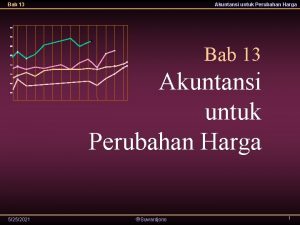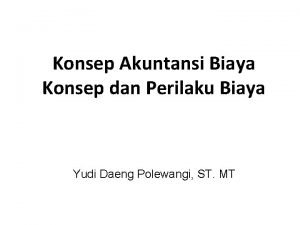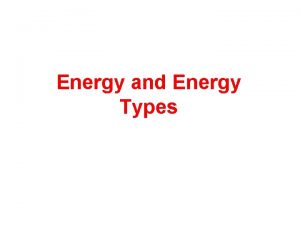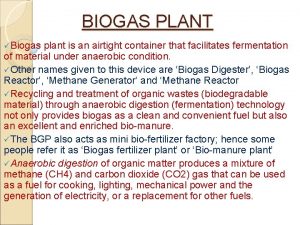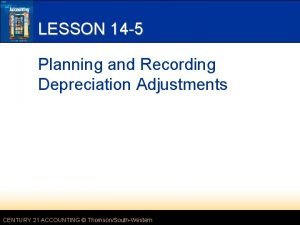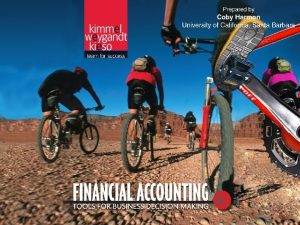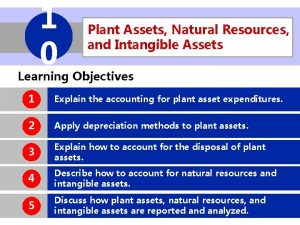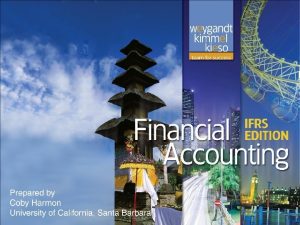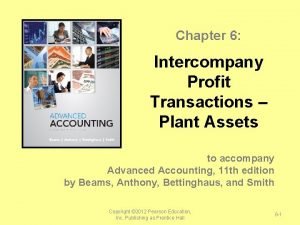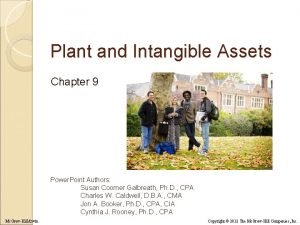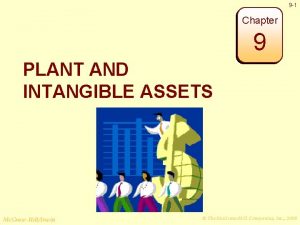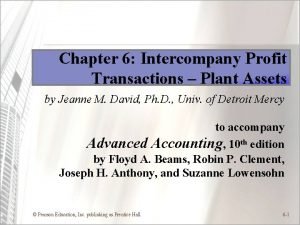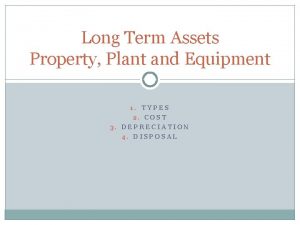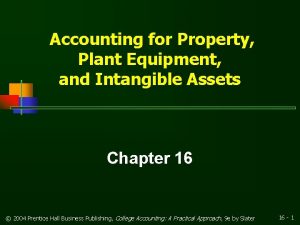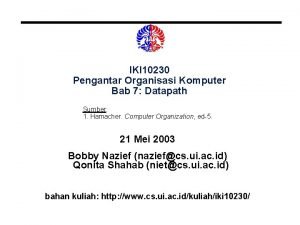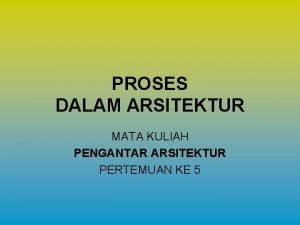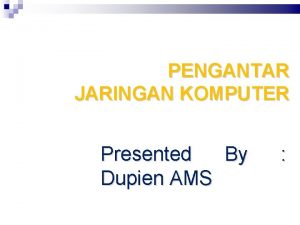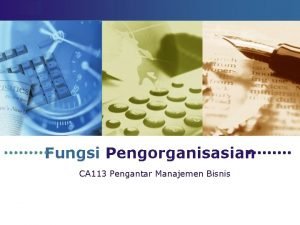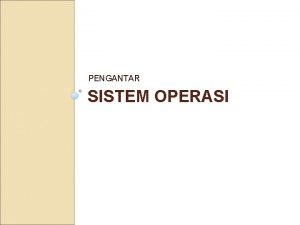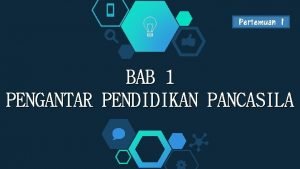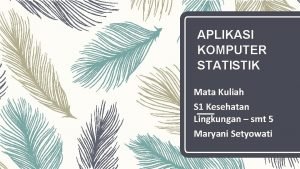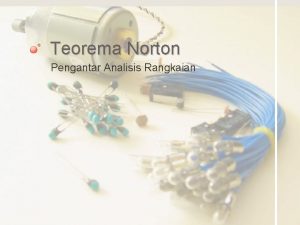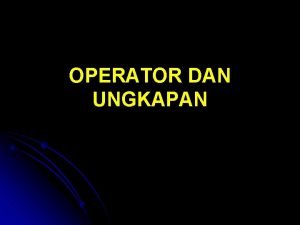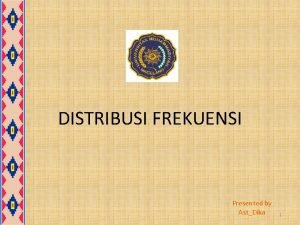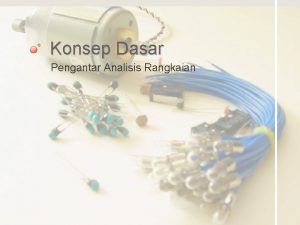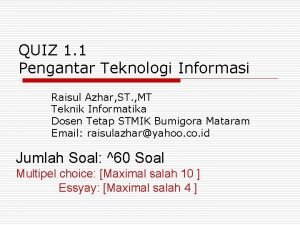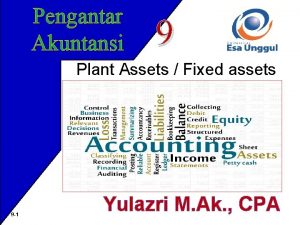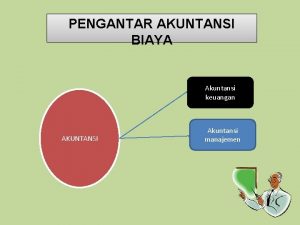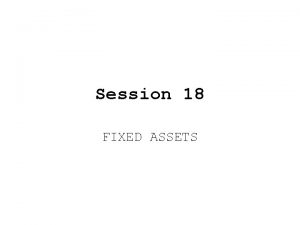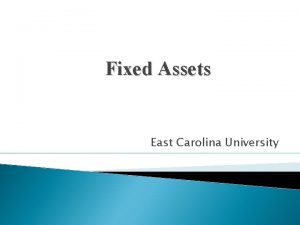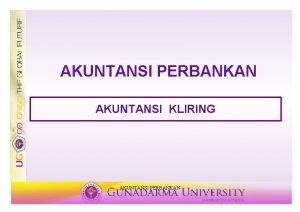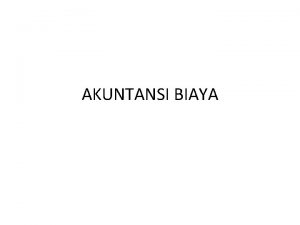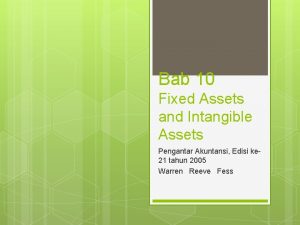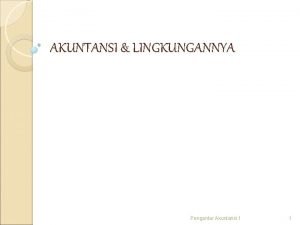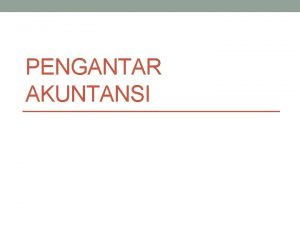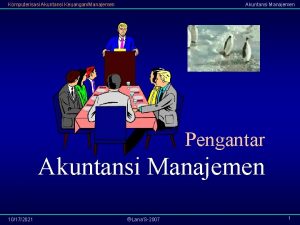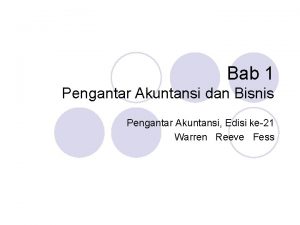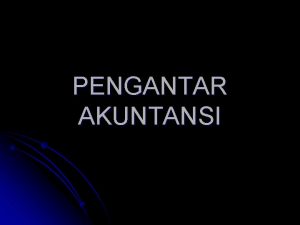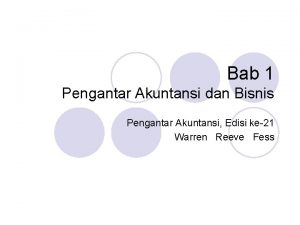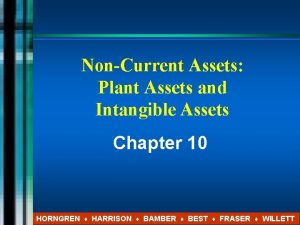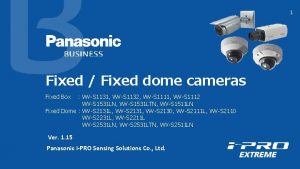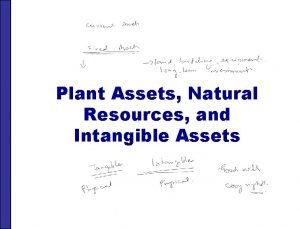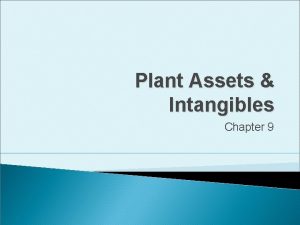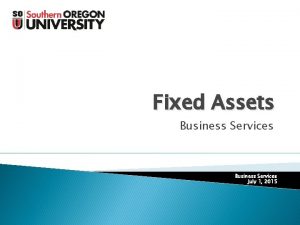Pengantar Akuntansi 8 Plant Assets Fixed assets 10














































































- Slides: 78

Pengantar Akuntansi 8 Plant Assets / Fixed assets 10 -1 Yulazri M. Ak. , CPA

10 Plant Assets, Natural Resources, and Intangible Assets Learning Objectives After studying this chapter, you should be able to: [1] Describe how the historical cost principle applies to plant assets. [2] Explain the concept of depreciation and how to compute it. [3] Distinguish between revenue and capital expenditures, and explain the entries for each. [4] Explain how to account for the disposal of a plant asset. [5] Compute periodic depletion of natural resources. [6] Explain the basic issues related to accounting for intangible assets. [7] Indicate how plant assets, natural resources, and intangible assets are reported. 10 -2

Preview of Chapter 10 Accounting Principles Eleventh Edition Weygandt Kimmel Kieso 10 -3

Plant Assets Plant assets are resources that have u physical substance (a definite size and shape), u are used in the operations of a business, u are not intended for sale to customers, u are expected to provide service to the company for a number of years. Referred to as property, plant, and equipment; plant and equipment; and fixed assets. 10 -4 LO 1 Describe how the cost principle applies to plant assets.

Plant Assets Plant assets are critical to a company’s success Illustration 10 -1 10 -5 LO 1 Describe how the cost principle applies to plant assets.

Plant Assets Determining the Cost of Plant Assets Cost Principle - requires that companies record plant assets at cost. Cost consists of all expenditures necessary to acquire an asset and make it ready for its intended use. 10 -6 LO 1 Describe how the cost principle applies to plant assets.

Determining the Cost of Plant Assets Land All necessary costs incurred in making land ready for its intended use increase (debit) the Land account. Costs typically include: 1) cash purchase price, 2) closing costs such as title and attorney’s fees, 3) real estate brokers’ commissions, and 4) accrued property taxes and other liens on the land assumed by the purchaser. 10 -7 LO 1 Describe how the cost principle applies to plant assets.

Determining the Cost of Plant Assets Illustration: Hayes Manufacturing Company acquires real estate at a cash cost of $100, 000. The property contains an old warehouse that is razed at a net cost of $6, 000 ($7, 500 in costs less $1, 500 proceeds from salvaged materials). Additional expenditures are the attorney’s fee, $1, 000, and the real estate broker’s commission, $8, 000. Required: Determine the amount to be reported as the cost of the land. 10 -8 LO 1 Describe how the cost principle applies to plant assets.

Determining the Cost of Plant Assets Required: Determine amount to be reported as the cost of the land. Land Cash price of property ($100, 000) Net removal cost of warehouse ($6, 000) 6, 000 Attorney's fees ($1, 000) 1, 000 Real estate broker’s commission ($8, 000) 8, 000 Cost of Land 10 -9 $100, 000 $115, 000 LO 1 Describe how the cost principle applies to plant assets.

Determining the Cost of Plant Assets Land Improvements Cost includes all expenditures necessary to make the improvements ready for their intended use. 10 -10 u Examples: driveways, parking lots, fences, landscaping, and lighting. u Limited useful lives. u Expense (depreciate) the cost of land improvements over their useful lives. LO 1 Describe how the cost principle applies to plant assets.

Determining the Cost of Plant Assets Buildings Includes all costs related directly to purchase or construction. Purchase costs: u Purchase price, closing costs (attorney’s fees, title insurance, etc. ) and real estate broker’s commission. u Remodeling and replacing or repairing the roof, floors, electrical wiring, and plumbing. Construction costs: u 10 -11 Contract price plus payments for architects’ fees, building permits, and excavation costs. LO 1 Describe how the cost principle applies to plant assets.

Determining the Cost of Plant Assets Equipment Include all costs incurred in acquiring the equipment and preparing it for use. Costs typically include: 10 -12 u Cash purchase price. u Sales taxes. u Freight charges. u Insurance during transit paid by the purchaser. u Expenditures required in assembling, installing, and testing the unit. LO 1 Describe how the cost principle applies to plant assets.

Determining the Cost of Plant Assets Illustration: Lenard Company purchases a delivery truck at a cash price of $22, 000. Related expenditures are sales taxes $1, 320, painting and lettering $500, motor vehicle license $80, and a three-year accident insurance policy $1, 600. Compute the cost of the delivery truck. Truck Cash price $22, 000 Sales taxes 1, 320 Painting and lettering Cost of Delivery Truck 10 -13 500 $23, 820 LO 1 Describe how the cost principle applies to plant assets.

Determining the Cost of Plant Assets Illustration: Lenard Company purchases a delivery truck at a cash price of $22, 000. Related expenditures are sales taxes $1, 320, painting and lettering $500, motor vehicle license $80, and a three-year accident insurance policy $1, 600. Prepare the journal entry to record these costs. Equipment 23, 820 License Expense Prepaid Insurance Cash 10 -14 80 1, 600 25, 500 LO 1 Describe how the cost principle applies to plant assets.

10 -15

Plant Assets Depreciation Process of allocating to expense the cost of a plant asset over its useful (service) life in a rational and systematic manner. 10 -16 u Process of cost allocation, not asset valuation. u Applies to land improvements, buildings, and equipment, not land. u Depreciable, because the revenue-producing ability of asset will decline over the asset’s useful life. LO 2 Explain the concept of depreciation.

Depreciation Factors in Computing Depreciation Illustration 10 -6 10 -17 Helpful Hint Depreciation expense is reported on the income statement. Accumulated depreciation is reported on the balance sheet as a deduction from plant assets. Alternative Terminology Another term sometimes used for salvage value is residual value. LO 2 Explain the concept of depreciation.

Depreciation Methods Management selects the method it believes best measures an asset’s contribution to revenue over its useful life. Examples include: (1) Straight-line method. (2) Units-of-activity method. (3) Declining-balance method. Illustration 10 -8 Use of depreciation methods in major U. S. companies 10 -18 LO 2

Depreciation Illustration: Barb’s Florists purchased a small delivery truck on January 1, 2014. Cost Expected salvage value $13, 000 $1, 000 Estimated useful life in years 5 Estimated useful life in miles 100, 000 Required: Compute depreciation using the following. (a) Straight-Line. (b) Units-of-Activity. (c) Declining Balance. 10 -19 LO 2 Explain the concept of depreciation.

Depreciation Straight-Line u Expense is same amount for each year. u Depreciable cost = Cost less salvage value. Illustration 10 -9 10 -20 LO 2 Explain the concept of depreciation.

Depreciation Illustration: (Straight-Line Method) 2014 $ 12, 000 2015 12, 000 2016 $ 2, 400 $ 10, 600 20 2, 400 4, 800 8, 200 12, 000 20 2, 400 7, 200 5, 800 2017 12, 000 20 2, 400 9, 600 3, 400 2018 12, 000 20 2, 400 12, 000 1, 000 2014 Journal Entry 10 -21 20% Illustration 9 -10 Depreciation expense 2, 400 Accumulated depreciation 2, 400 LO 2 Explain the concept of depreciation.

Depreciation Partial Year Illustration: (Straight-Line Method) Assume the delivery truck was purchased on April 1, 2014. 10 -22 LO 2

Depreciation Units-of-Activity u Companies estimate total units of activity to calculate depreciation cost per unit. u Expense varies based on units of activity. u Depreciable cost is cost less salvage value. Illustration 10 -11 Alternative Terminology Another term often used is the units-of-production method. 10 -23 LO 2 Explain the concept of depreciation.

Depreciation Illustration: (Units-of-Activity Method) Illustration 10 -12 2014 15, 000 $ 0. 12 $ 1, 800 $ 11, 200 2015 30, 000 0. 12 3, 600 5, 400 7, 600 2016 20, 000 0. 12 2, 400 7, 800 5, 200 2017 25, 000 0. 12 3, 000 10, 800 2, 200 2018 10, 000 0. 12 1, 200 12, 000 1, 000 2014 Journal Entry 10 -24 Depreciation expense 1, 800 Accumulated depreciation 1, 800 LO 2 Explain the concept of depreciation.

Depreciation Declining-Balance 10 -25 u Accelerated method. u Decreasing annual depreciation expense over the asset’s useful life. u Twice the straight-line rate with Double-Declining-Balance. u Rate applied to book value. Illustration 10 -13 LO 2 Explain the concept of depreciation.

Depreciation Illustration: (Declining-Balance Method) Illustration 10 -14 2014 13, 000 40% $ 5, 200 $ 7, 800 2015 7, 800 40 3, 120 8, 320 4, 680 2016 4, 680 40 1, 872 10, 192 2, 808 2017 2, 808 40 1, 123 11, 315 1, 685 2018 1, 685 40 12, 000 1, 000 2014 Journal Entry 10 -26 685* Depreciation expense 5, 200 Accumulated depreciation * Computation of $674 ($1, 685 x 40%) is adjusted to $685. 5, 200 LO 2

Depreciation Partial Year Illustration: (Declining-Balance Method) 10 -27 LO 2 Explain the concept of depreciation.

Depreciation Illustration 10 -15 Comparison of Methods Illustration 10 -16 Each method is acceptable because each recognizes the decline in service potential of the asset in a rational and systematic manner. 10 -28 LO 2

Depreciation and Income Taxes IRS does not require taxpayer to use the same depreciation method on the tax return that is used in preparing financial statements. IRS requires the straight-line method or a special accelerateddepreciation method called the Modified Accelerated Cost Recovery System (MACRS). MACRS is NOT acceptable under GAAP. 10 -29 LO 2 Explain the concept of depreciation.

Depreciation Revising Periodic Depreciation u Accounted for in the period of change and future periods (Change in Estimate). 10 -30 u Not handled retrospectively. u Not considered error. LO 2 Explain the concept of depreciation.

Depreciation Illustration: Arcadia HS, purchased equipment for $510, 000 which was estimated to have a useful life of 10 years with a salvage value of $10, 000 at the end of that time. Depreciation has been recorded for 7 years on a straight-line basis. In 2014 (year 8), it is determined that the total estimated life should be 15 years with a salvage value of $5, 000 at the end of that time. Questions: 10 -31 u What is the journal entry to correct the prior years’ depreciation? u Calculate the depreciation expense for 2014. No Entry Required LO 2 Explain the concept of depreciation.

Depreciation Equipment cost Salvage value Depreciable base Useful life (original) Annual depreciation After 7 years $510, 000 First, establish NBV - 10, 000 at date of change in estimate. 500, 000 10 years $ 50, 000 x 7 years = $350, 000 Balance Sheet (Dec. 31, 2014) Plant Assets: 10 -32 Equipment Accumulated depreciation $510, 000 350, 000 Net book value (NBV) $160, 000 LO 2 Explain the concept of depreciation.

Depreciation Net book value Salvage value (new) Depreciable base Useful life remaining Annual depreciation After 7 years $160, 000 - 5, 000 155, 000 8 years $ 19, 375 Depreciation Expense calculation for 2014. Journal entry for 2014 and future years. Depreciation Expense 19, 375 Accumulated Depreciation 10 -33 19, 375 LO 2 Explain the concept of depreciation.

Plant Assets Expenditures During Useful Life Ordinary Repairs - expenditures to maintain the operating efficiency and productive life of the unit. u Debit - Repair (or Maintenance) Expense. u Referred to as revenue expenditures. Additions and Improvements - costs incurred to increase the operating efficiency, productive capacity, or useful life of a plant asset. 10 -34 u Debit - the plant asset affected. u Referred to as capital expenditures. LO 3 Distinguish between revenue and capital expenditures, and explain the entries for each.

ANATOMY OF A FRAUD Bernie Ebers was the founder and CEO of the phone company World. Com. The company engaged in a series of increasingly large, debt-financed acquisitions of other companies. These acquisitions made the company grow quickly, which made the stock price increase dramatically. However, because the acquired companies all had different accounting systems, World. Com’s financial records were a mess. When World. Com’s performance started to flatten out, Bernie coerced World. Com’s accountants to engage in a number of fraudulent activities to make net income look better than it really was and thus prop up the stock price. One of these frauds involved treating $7 billion of line costs as capital expenditures. The line costs, which were rental fees paid to other phone companies to use their phone lines, had always been properly expensed in previous years. Capitalization delayed expense recognition to future periods and thus boosted current-period profits. Total take: $7 billion THE MISSING CONTROLS Documentation procedures. The company’s accounting system was a disorganized collection of non-integrated systems, which resulted from a series of corporate acquisitions. Top management took advantage of this disorganization to conceal its fraudulent activities. Independent internal verification. A fraud of this size should have been detected by a routine comparison of the actual physical assets with the list of physical assets shown in the accounting records. 10 -35 Advance slide in presentation mode to reveal answer.

Plant Asset Disposals Companies dispose of plant assets in three ways —Retirement, Sale, or Exchange (appendix). Illustration 10 -18 Record depreciation up to the date of disposal. Eliminate asset by (1) debiting Accumulated Depreciation, and (2) crediting the asset account. 10 -36 LO 4 Explain how to account for the disposal of a plant asset.

Plant Asset Disposals Retirement of Plant Assets 10 -37 u No cash is received. u Decrease (debit) Accumulated Depreciation for the full amount of depreciation taken over the life of the asset. u Decrease (credit) the asset account for the original cost of the asset. LO 4 Explain how to account for the disposal of a plant asset.

Plant Asset Disposals Illustration: Hobart Enterprises retires its computer printers, which cost $32, 000. The accumulated depreciation on these printers is $32, 000. Prepare the entry to record this retirement. Accumulated Depreciation Equipment 32, 000 Question: What happens if a fully depreciated plant asset is still useful to the company? 10 -38 LO 4 Explain how to account for the disposal of a plant asset.

Plant Asset Disposals Illustration: Sunset Company discards delivery equipment that cost $18, 000 and has accumulated depreciation of $14, 000. The journal entry is? Accumulated Depreciation Loss on Disposal Equipment 14, 000 18, 000 Companies report a loss on disposal in the “Other expenses and losses” section of the income statement. 10 -39 LO 4 Explain how to account for the disposal of a plant asset.

Plant Asset Disposals Sale of Plant Assets Compare the book value of the asset with the proceeds received from the sale. 10 -40 u If proceeds exceed the book value, a gain on disposal occurs. u If proceeds are less than the book value, a loss on disposal occurs. LO 4 Explain how to account for the disposal of a plant asset.

Plant Asset Disposals Gain on Sale Illustration: On July 1, 2014, Wright Company sells office furniture for $16, 000 cash. The office furniture originally cost $60, 000. As of January 1, 2014, it had accumulated depreciation of $41, 000. Depreciation for the first six months of 2014 is $8, 000. Prepare the journal entry to record depreciation expense up to the date of sale. July 1 Depreciation Expense Accumulated Depreciation 10 -41 8, 000 LO 4 Explain how to account for the disposal of a plant asset.

Plant Asset Disposals Illustration 10 -19 Computation of gain on disposal Illustration: Wright records the sale as follows. July 1 Cash 16, 000 Accumulated Depreciation 49, 000 Equipment Gain on Disposal 10 -42 60, 000 5, 000 LO 4 Explain how to account for the disposal of a plant asset.

Plant Asset Disposals Illustration: Assume that instead of selling the office furniture for $16, 000, Wright sells it for $9, 000. Illustration 10 -20 Computation of loss on disposal July 1 Cash 9, 000 Accumulated Depreciation Loss on Disposal Equipment 10 -43 49, 000 2, 000 60, 000 LO 4 Explain how to account for the disposal of a plant asset.

Natural Resources Natural resources consist of standing timber and underground deposits of oil, gas, and minerals. Distinguishing characteristics: 10 -44 u Physically extracted in operations. u Replaceable only by an act of nature. LO 5 Compute periodic depletion of natural resources.

Natural Resources Cost - price needed to acquire the resource and prepare it for its intended use. Depletion The allocation of the cost to expense in a rational and systematic manner over the resource’s useful life. 10 -45 u Depletion is to natural resources as depreciation is to plant assets. u Companies generally use units-of-activity method. u Depletion generally is a function of the units extracted and sold. LO 5 Compute periodic depletion of natural resources.

Natural Resources Illustration: Lane Coal Company invests $5 million in a mine estimated to have 10 million tons of coal and no salvage value. In the first year, Lane extracts and sells 800, 000 tons of coal. Lane computes the depletion expense as follows: $5, 000 ÷ 10, 000 = $. 50 depletion cost per ton $. 50 x 800, 000 = $400, 000 depletion expense Journal entry: Depletion expense Accumulated Depletion 10 -46 400, 000 LO 5 Compute periodic depletion of natural resources.

Natural Resources Depletion Illustration 10 -22 Statement presentation of accumulated depletion Extracted resources that have not been sold are reported as inventory in the current assets section. 10 -47 LO 5 Compute periodic depletion of natural resources.

Intangible Assets Intangible assets are rights, privileges, and competitive advantages that result from ownership of long-lived assets that do not possess physical substance. Limited life or indefinite life. Common types of intangibles: 10 -48 u Patents u Trademarks and Trade Names u Copyrights u Franchises or Licenses u Goodwill LO 6 Explain the basic issues related to accounting for intangible assets.

Accounting for Intangible Assets Limited-Life Intangibles: u Amortize to expense. u Credit asset account. Helpful Hint Amortization is to intangibles what depreciation is to plant assets and depletion is to natural resources. Indefinite-Life Intangibles: 10 -49 u No foreseeable limit on time the asset is expected to provide cash flows. u No amortization. LO 6 Explain the basic issues related to accounting for intangible assets.

Accounting for Intangible Assets Patents 10 -50 u Exclusive right to manufacture, sell, or otherwise control an invention for a period of 20 years from the date of the grant. u Capitalize costs of purchasing a patent and amortize over its 20 -year life or its useful life, whichever is shorter. u Expense any R&D costs in developing a patent. u Legal fees incurred successfully defending a patent are capitalized to Patent account. LO 6 Explain the basic issues related to accounting for intangible assets.

Accounting for Intangible Assets Illustration: National Labs purchases a patent at a cost of $60, 000 on June 30. National estimates the useful life of the patent to be eight years. Prepare the journal entry to record the amortization for the six-month period ended December 31. Cost Useful life Annual expense 6 months Amortization Dec. 31 Amortization Expense Patent 10 -51 $60, 000 ÷ 8 $ 7, 500 x 6/12 $ 3, 750 LO 6

Accounting for Intangible Assets Copyrights u Give the owner the exclusive right to reproduce and sell an artistic or published work. 10 -52 u Granted for the life of the creator plus 70 years. u Capitalize costs of acquiring and defending it. u Amortized to expense over useful life. LO 6 Explain the basic issues related to accounting for intangible assets.

Accounting for Intangible Assets Trademarks and Trade Names u Word, phrase, jingle, or symbol that identifies a particular enterprise or product. ► Wheaties, Monopoly, Kleenex, Coca-Cola, Big Mac, and Jeep. 10 -53 u Legal protection for indefinite number of 20 year renewal periods. u Capitalize acquisition costs. u No amortization. LO 6 Explain the basic issues related to accounting for intangible assets.

Accounting for Intangible Assets Franchises and Licenses u Contractual arrangement between a franchisor and a franchisee. ► 10 -54 Shell, Subway, and Rent-A-Wreck are franchises. u Franchise (or license) with a limited life should be amortized to expense over the life of the franchise. u Franchise with an indefinite life should be carried at cost and not amortized. LO 6 Explain the basic issues related to accounting for intangible assets.

Accounting for Intangible Assets Goodwill 10 -55 u Includes exceptional management, desirable location, good customer relations, skilled employees, high-quality products, etc. u Only recorded when an entire business is purchased. u Goodwill is recorded as the excess of purchase price over the FMV of the identifiable net assets acquired. u Internally created goodwill should not be capitalized. u Not amortized. LO 6 Explain the basic issues related to accounting for intangible assets.

Accounting for Intangible Assets Research and Development Costs Expenditures that may lead to u patents, u copyrights, u new processes, and u new products. All R & D costs are expensed when incurred. Helpful Hint Research and development (R&D) costs are not intangible assets. But because they may lead to patents and copyrights, we discuss them in this section. 10 -56 LO 6 Explain the basic issues related to accounting for intangible assets.

> DO IT! Illustration: Identify the term most directly associated with each statement. 1. The allocation of the cost of a natural resource to expense in a rational and systematic manner. 2. Rights, privileges, and competitive advantages that result from the ownership of long-lived assets that do not possess physical substance. 3. An exclusive right granted by the federal government to reproduce and sell an artistic or published work. 10 -57 Depletion Intangible Assets Copyrights LO 6 Explain the basic issues related to accounting for intangible assets.

> DO IT! Illustration: Identify the term most directly associated with each statement. 4. A right to sell certain products or services or to use certain trademarks or trade names within a designated geographic area. 5. Costs incurred by a company that often lead to patents or new products. These costs must be expensed as incurred. 10 -58 Franchise Research and Development Costs LO 6 Explain the basic issues related to accounting for intangible assets.

10 -59

Statement Presentation and Analysis Presentation 10 -60 Illustration 10 -23 LO 7 Indicate how plant assets, natural resources, and intangible assets are reported.

Statement Presentation and Analysis Illustration 10 -25 Each dollar invested in assets produced $0. 62 in sales. If a company is using its assets efficiently, each dollar of assets will create a high amount of sales. 10 -61 LO 7 Indicate how plant assets, natural resources, and intangible assets are reported.

APPENDIX 10 A 10 -62 Exchange of Plant Assets u Ordinarily, companies record a gain or loss on the exchange of plant assets. u Most exchanges have commercial substance. u Commercial substance - if the future cash flows change as a result of the exchange. LO 8 Explain how to account for the exchange of plant assets.

APPENDIX 10 A Exchange of Plant Assets Illustration: Roland Co. exchanged old trucks (cost $64, 000 less $22, 000 accumulated depreciation) plus cash of $17, 000 for a new semi-truck. The old trucks had a fair market value of $26, 000. 10 -63 Cost of old trucks Less: Accumulated depreciation Book value Fair market value of old trucks Loss on disposal $64, 000 22, 000 42, 000 26, 000 $16, 000 Fair market value of old trucks Cash paid Cost of new truck $26, 000 17, 000 $43, 000 Illustration 10 A -1 & 10 A-2 LO 8 Explain how to account for the exchange of plant assets.

APPENDIX 10 A Exchange of Plant Assets Illustration: Roland Co. exchanged old trucks (cost $64, 000 less $22, 000 accumulated depreciation) plus cash of $17, 000 for a new semi-truck. The old trucks had a fair market value of $26, 000. Prepare the entry to record the exchange of assets by Roland Co. 10 -64 Equipment (new) 43, 000 Accumulated Depreciation 22, 000 Loss on Disposal 16, 000 Equipment (old) 64, 000 Cash 17, 000 LO 8 Explain how to account for the exchange of plant assets.

APPENDIX 10 A Exchange of Plant Assets Illustration: Mark Express Delivery trades its old delivery equipment (cost $40, 000 less $28, 000 accumulated depreciation) for new delivery equipment. The old equipment had a fair market value of $19, 000. Mark also paid $3, 000. 10 -65 Cost of old equipment Less: Accumulated depreciation Book value Fair market value of old equipment Gain on disposal $40, 000 28, 000 12, 000 19, 000 $ 7, 000 Fair market value of old equipment Cash paid Cost of new equipment $19, 000 3, 000 $22, 000 Illustration 10 A-3 & 10 A-4 LO 8 Explain how to account for the exchange of plant assets.

APPENDIX 10 A Exchange of Plant Assets Illustration: Mark Express Delivery trades its old delivery equipment (cost $40, 000 less $28, 000 accumulated depreciation) for new delivery equipment. The old equipment had a fair market value of $19, 000. Mark also paid $3, 000. Prepare the entry to record the exchange of assets by Mark Express. 10 -66 Equipment (new) 22, 000 Accumulated Depreciation 28, 000 Equipment (used) 40, 000 Gain on Disposal 7, 000 Cash 3, 000 LO 8 Explain how to account for the exchange of plant assets.

A Look at IFRS Key Points 10 -67 u The definition for plant assets for both IFRS and GAAP is essentially the same. u Both IFRS and GAAP follow the historical cost principle when accounting for property, plant, and equipment at date of acquisition. u Under both IFRS and GAAP, interest costs incurred during construction are capitalized. Recently, IFRS converged to GAAP requirements in this area. u IFRS, like GAAP, capitalizes all direct costs in self-constructed assets such as raw materials and labor. IFRS does not address the capitalization of fixed overhead although in practice these costs are generally capitalized. LO 9 Compare the accounting procedures for longlived assets under GAAP and IFRS.

A Look at IFRS Key Points 10 -68 u IFRS also views depreciation as an allocation of cost over an asset’s useful life. IFRS permits the same depreciation methods (e. g. , straightline, accelerated, and units-of-activity) as GAAP. However, a major difference is that IFRS requires component depreciation. Component depreciation specifies that any significant parts of a depreciable asset that have different estimated useful lives should be separately depreciated. Component depreciation is allowed under GAAP but is seldom used. u IFRS uses the term residual value rather than salvage value to refer to an owner’s estimate of an asset’s value at the end of its useful life for that owner. LO 9 Compare the accounting procedures for longlived assets under GAAP and IFRS.

A Look at IFRS Key Points 10 -69 u IFRS allows companies to revalue plant assets to fair value at the reporting date. Companies that choose to use the revaluation framework must follow revaluation procedures. If revaluation is used, it must be applied to all assets in a class of assets. Assets that are experiencing rapid price changes must be revalued on an annual basis, otherwise less frequent revaluation is acceptable. u Under both GAAP and IFRS, changes in the depreciation method used and changes in useful life are handled in current and future periods. Prior periods are not affected. GAAP recently conformed to international standards in the accounting for changes in depreciation methods. LO 9 Compare the accounting procedures for longlived assets under GAAP and IFRS.

A Look at IFRS Key Points 10 -70 u The accounting for subsequent expenditures, such as ordinary repairs and additions, are essentially the same under IFRS and GAAP. u The accounting for plant asset disposals is essentially the same under IFRS and GAAP. u Initial costs to acquire natural resources are essentially the same under IFRS and GAAP. u The definition of intangible assets is essentially the same under IFRS and GAAP. LO 9 Compare the accounting procedures for longlived assets under GAAP and IFRS.

A Look at IFRS Key Points 10 -71 u As in GAAP, under IFRS the costs associated with research and development are segregated into the two components. Costs in the research phase are always expensed under both IFRS and GAAP. Under IFRS, however, costs in the development phase are capitalized as Development Costs once technological feasibility is achieved. u IFRS permits revaluation of intangible assets (except for goodwill). GAAP prohibits revaluation of intangible assets. LO 9 Compare the accounting procedures for longlived assets under GAAP and IFRS.

A Look at IFRS Key Points u 10 -72 IFRS requires an impairment test at each reporting date for plant assets and intangibles and records an impairment if the asset’s carrying amount exceeds its recoverable amount. The recoverable amount is the higher of the asset’s fair value less costs to sell or its value-in-use. Value-in-use is the future cash flows to be derived from the particular asset, discounted to present value. Under GAAP, impairment loss is measured as the excess of the carrying amount over the asset’s fair value. LO 9 Compare the accounting procedures for longlived assets under GAAP and IFRS.

A Look at IFRS Key Points 10 -73 u IFRS allows reversal of impairment losses when there has been a change in economic conditions or in the expected use of the asset. Under GAAP, impairment losses cannot be reversed for assets to be held and used; the impairment loss results in a new cost basis for the asset. IFRS and GAAP are similar in the accounting for impairments of assets held for disposal. u The accounting for exchanges of nonmonetary assets has recently converged between IFRS and GAAP now requires that gains on exchanges of nonmonetary assets be recognized if the exchange has commercial substance. This is the same framework used in IFRS. LO 9 Compare the accounting procedures for longlived assets under GAAP and IFRS.

A Look at IFRS Looking to the Future It is too early to say whether a converged conceptual framework will recommend fair value measurement (and revaluation accounting) for plant assets and intangibles. The IASB and FASB have identified a project that would consider expanded recognition of internally generated intangible assets. IFRS permits more recognition of intangibles compared to GAAP. Thus, it will be challenging to develop converged standards for intangible assets, given the long-standing prohibition on capitalizing internally generated intangible assets and research and development costs in GAAP. 10 -74 LO 9 Compare the accounting procedures for longlived assets under GAAP and IFRS.

A Look at IFRS Self-Test Questions Which of the following statements is correct? a) Both IFRS and GAAP permit revaluation of property, plant, and equipment and intangible assets (except for goodwill). b) IFRS permits revaluation of property, plant, and equipment and intangible assets (except for goodwill). c) Both IFRS and GAAP permit revaluation of property, plant, and equipment but not intangible assets. d) GAAP permits revaluation of property, plant, and equipment but not intangible assets. 10 -75 LO 9 Compare the accounting procedures for longlived assets under GAAP and IFRS.

A Look at IFRS Self-Test Questions Research and development costs are: a) expensed under GAAP. b) expensed under IFRS. c) expensed under both GAAP and IFRS. d) None of the above. 10 -76 LO 9 Compare the accounting procedures for longlived assets under GAAP and IFRS.

A Look at IFRS Self-Test Questions Under IFRS, value-in-use is defined as: a) net realizable value. b) fair value. c) future cash flows discounted to present value. d) total future undiscounted cash flows. 10 -77 LO 9 Compare the accounting procedures for longlived assets under GAAP and IFRS.

Prepared by Coby Harmon University of California, Santa Barbara Westmont College 10 -78
 Fixed assets property plant equipment
Fixed assets property plant equipment Accumulated depreciation straight line method
Accumulated depreciation straight line method Plant assets, natural resources, and intangible assets
Plant assets, natural resources, and intangible assets Plant assets are ordinarily presented in the balance sheet
Plant assets are ordinarily presented in the balance sheet Rangkuman pengantar akuntansi bab 1
Rangkuman pengantar akuntansi bab 1 Modul pengantar akuntansi 2
Modul pengantar akuntansi 2 Contoh soal piutang dagang pengantar akuntansi 2
Contoh soal piutang dagang pengantar akuntansi 2 Pengantar akuntansi dan bisnis
Pengantar akuntansi dan bisnis Akuntansi pengantar 2
Akuntansi pengantar 2 Contoh soal obligasi pengantar akuntansi 2
Contoh soal obligasi pengantar akuntansi 2 Peta konsep sejarah akuntansi
Peta konsep sejarah akuntansi Pengantar akuntansi 1 berbasis ifrs
Pengantar akuntansi 1 berbasis ifrs Materi obligasi pengantar akuntansi 2
Materi obligasi pengantar akuntansi 2 Modul pengantar akuntansi 1
Modul pengantar akuntansi 1 Buku pengantar akuntansi 1 adaptasi indonesia edisi 4
Buku pengantar akuntansi 1 adaptasi indonesia edisi 4 Materi modal saham dan laba ditahan
Materi modal saham dan laba ditahan Pengantar akuntansi 2 ppt
Pengantar akuntansi 2 ppt Fixed interval positive reinforcement
Fixed interval positive reinforcement Introduction to programmable logic devices
Introduction to programmable logic devices Theory of insightful learning
Theory of insightful learning Fixed interval vs fixed ratio
Fixed interval vs fixed ratio Fixed order quantity vs fixed time period
Fixed order quantity vs fixed time period Long-term assets
Long-term assets Nature of fixed assets
Nature of fixed assets Fixed assets in tally
Fixed assets in tally Cayenta fixed assets
Cayenta fixed assets If a plant asset is retired and is fully depreciated
If a plant asset is retired and is fully depreciated Non fixed assets examples
Non fixed assets examples Strack houseware supplies inc
Strack houseware supplies inc Fixed assets examples
Fixed assets examples New era accounting grade 10 memo pdf module 5
New era accounting grade 10 memo pdf module 5 Cash flow to creditors
Cash flow to creditors Cas 500
Cas 500 Fixed assets schedule
Fixed assets schedule Tangible assets note
Tangible assets note Lanni products is a start up computer
Lanni products is a start up computer Real vs financial assets
Real vs financial assets Real assets vs financial assets
Real assets vs financial assets Real assets definition
Real assets definition Teori akuntansi bab 13 akuntansi untuk perubahan harga
Teori akuntansi bab 13 akuntansi untuk perubahan harga Sebutkan dua tipe akuntansi dan jelaskan
Sebutkan dua tipe akuntansi dan jelaskan Persamaan akuntansi keuangan dan manajemen
Persamaan akuntansi keuangan dan manajemen Teori akuntansi bab 13 akuntansi untuk perubahan harga
Teori akuntansi bab 13 akuntansi untuk perubahan harga Teori akuntansi bab 13 akuntansi untuk perubahan harga
Teori akuntansi bab 13 akuntansi untuk perubahan harga Hubungan akuntansi biaya dengan akuntansi keuangan
Hubungan akuntansi biaya dengan akuntansi keuangan Peranan akuntansi kos bagi manajemen adalah
Peranan akuntansi kos bagi manajemen adalah Biogas plant
Biogas plant Biogas is formed in the presence of
Biogas is formed in the presence of Recorded depreciation expense on the plant assets
Recorded depreciation expense on the plant assets Tax payable in cash flow statement
Tax payable in cash flow statement Truck and plant assets
Truck and plant assets Retirement of plant assets
Retirement of plant assets Intercompany profit transactions plant assets
Intercompany profit transactions plant assets Chapter 9 plant and intangible assets
Chapter 9 plant and intangible assets Plant and intangible assets chapter 9
Plant and intangible assets chapter 9 Intercompany profit transactions plant assets
Intercompany profit transactions plant assets Net book value
Net book value Property, plant, and equipment and intangible assets are
Property, plant, and equipment and intangible assets are Tronsmo plant pathology and plant diseases download
Tronsmo plant pathology and plant diseases download Taichum
Taichum Albugo eye
Albugo eye Plant introduction in plant breeding
Plant introduction in plant breeding Define plant breeding
Define plant breeding Tronsmo plant pathology and plant diseases download
Tronsmo plant pathology and plant diseases download Mov r
Mov r Anjab pengantar kerja
Anjab pengantar kerja Silabus pengantar ilmu hukum
Silabus pengantar ilmu hukum Mata kuliah pengantar arsitektur
Mata kuliah pengantar arsitektur Ip kelas c
Ip kelas c Logo pengantar manajemen
Logo pengantar manajemen Translator teknik kompilasi
Translator teknik kompilasi Definisi dari sistem operasi
Definisi dari sistem operasi Pengantar pendidikan pancasila
Pengantar pendidikan pancasila Mata kuliah aplikasi komputer statistik
Mata kuliah aplikasi komputer statistik Pengantar analisis rangkaian
Pengantar analisis rangkaian Ungkapan pengantar
Ungkapan pengantar Pengertian interval kelas
Pengertian interval kelas Pengantar analisis rangkaian
Pengantar analisis rangkaian Pc tergolong sebagai
Pc tergolong sebagai
